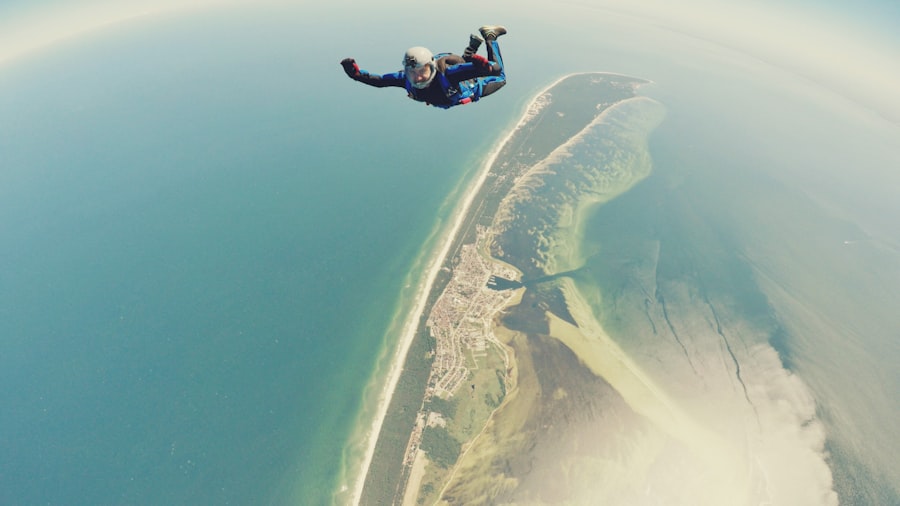Download links
How to install Soaring to New Heights: The Thrill of Wingsuit Flying APK?
1. Tap the downloaded Soaring to New Heights: The Thrill of Wingsuit Flying APK file.
2. Touch install.
3. Follow the steps on the screen.
Description
Wingsuit flying, a breathtaking blend of human ingenuity and the primal desire for flight, has its roots in the early 20th century. The concept of gliding through the air with a suit designed to mimic the wings of birds can be traced back to the pioneering efforts of aviators and inventors.
Although his endeavor ended tragically, it laid the groundwork for future innovations in human flight. The modern era of wingsuit flying began in the late 1990s, when enthusiasts began to experiment with more advanced designs that allowed for greater control and maneuverability. The first wingsuits were rudimentary, often resembling a simple jumpsuit with fabric stretched between the arms and legs.
However, as technology progressed, so did the design of wingsuits. By the early 2000s, wingsuits had evolved significantly, incorporating materials that enhanced aerodynamics and stability. Pioneers like Jeb Corliss and Patrick de Gayardon pushed the boundaries of what was possible, performing daring jumps from cliffs and mountains, showcasing the potential of this exhilarating sport.
Key Takeaways
- Wingsuit flying has a history dating back to the early 20th century, with pioneers like Clem Sohn and Rex Finney making significant contributions to the sport.
- The physics behind wingsuit flying involves the principles of aerodynamics and lift, allowing wingsuit pilots to achieve forward motion and control their descent.
- Training and safety measures for wingsuit flying are crucial, with extensive training and the use of specialized equipment such as altimeters and parachutes to ensure a safe experience.
- Some of the most popular wingsuit flying locations include the Swiss Alps, Lauterbrunnen Valley, and the mountains of Norway, offering breathtaking scenery and challenging terrain for experienced pilots.
- Wingsuit flying provides an unparalleled adrenaline rush, with the sensation of flying at high speeds and the breathtaking views creating an unforgettable experience for enthusiasts.
- The future of wingsuit flying technology is focused on improving safety and performance, with advancements in wing design, materials, and safety equipment shaping the evolution of the sport.
The Physics Behind Wingsuit Flying
Understanding the physics behind wingsuit flying is essential for both enthusiasts and those interested in the mechanics of flight. At its core, wingsuit flying relies on the principles of aerodynamics, particularly lift and drag. When a wingsuit pilot jumps from a height, they enter free fall, and their body begins to accelerate towards the ground due to gravity.
However, the design of the wingsuit creates a significant amount of lift, allowing the pilot to glide horizontally rather than plummeting straight down. The wingsuit’s shape is crucial in generating lift. The fabric wings extend from the pilot’s arms to their legs, creating a larger surface area that interacts with the air.
As the pilot moves through the atmosphere, air flows over and under these surfaces, generating lift according to Bernoulli’s principle. This principle states that an increase in the speed of a fluid occurs simultaneously with a decrease in pressure. In simpler terms, as air moves faster over the top of the wingsuit, it creates lower pressure above the suit compared to the higher pressure below it, resulting in lift.
Another important aspect of wingsuit flying is drag, which is the resistance experienced as an object moves through air. While lift allows a wingsuit pilot to glide, drag works against this motion, slowing them down. The design of modern wingsuits aims to minimize drag while maximizing lift.
Pilots must also be aware of their body position; by adjusting their posture—whether by tucking in their arms or spreading them out—they can influence both lift and drag, allowing for more controlled flight paths.
Training and Safety Measures for Wingsuit Flying

Training for wingsuit flying is a rigorous process that requires dedication and a strong foundation in skydiving techniques. Before donning a wingsuit, aspiring pilots must first complete a series of skydives with a standard parachute to develop essential skills such as freefall control and parachute deployment. Most experts recommend completing at least 100 jumps before transitioning to wingsuit flying.
This experience helps pilots understand body positioning during freefall and how to manage their descent effectively. Once a skydiver has gained sufficient experience, they can begin wingsuit training under the guidance of certified instructors. This training typically involves jumps with specialized wingsuits designed for beginners, which offer more stability and easier handling.
Instructors teach pilots how to control their flight path, manage speed, and execute safe landings. Safety measures are paramount; pilots are trained to recognize potential hazards and respond appropriately during flight. Additionally, many wingsuit pilots use advanced parachute systems equipped with automatic activation devices (AADs) that deploy the parachute if they reach a certain altitude without having done so manually.
Safety is further enhanced through community practices and regulations established by organizations such as the United States Parachute Association (USPA) and similar bodies worldwide. These organizations provide guidelines on minimum jump requirements, recommended gear, and best practices for safe wingsuit flying. Regular safety briefings and discussions within the wingsuit community help pilots stay informed about new techniques and potential risks associated with this thrilling sport.
The Most Popular Wingsuit Flying Locations
| Location | Country | Altitude (ft) | Distance (miles) |
|---|---|---|---|
| Chamonix | France | 12,605 | 2.5 |
| Lauterbrunnen | Switzerland | 9,744 | 2.2 |
| Walensee | Switzerland | 6,562 | 1.9 |
| Zion National Park | USA | 8,726 | 2.8 |
Wingsuit flying attracts adventurers from around the globe, drawn to locations that offer breathtaking landscapes and ideal conditions for flight. One of the most iconic spots is Lauterbrunnen Valley in Switzerland, often referred to as the “Valley of 72 Waterfalls.” The towering cliffs and stunning alpine scenery provide an exhilarating backdrop for wingsuit pilots. The valley’s unique geography allows for long glides and spectacular views, making it a favorite among experienced flyers.
Another popular destination is the Troll Wall in Norway, known for its sheer vertical drop of over 1,800 meters (5,900 feet). This dramatic cliff face presents both challenges and rewards for wingsuit pilots. The combination of altitude and stunning fjord views creates an unforgettable experience for those brave enough to leap from its heights.
The region’s unpredictable weather conditions add an element of excitement; pilots must be adept at assessing wind patterns and visibility before making their jump. In addition to these iconic locations, many wingsuit enthusiasts flock to areas like Moab in Utah, USA, where sandstone cliffs provide ample opportunities for thrilling jumps. The unique rock formations create an otherworldly landscape that enhances the experience of freefalling through the air.
Similarly, regions like the Dolomites in Italy offer breathtaking mountain scenery that attracts both novice and seasoned wingsuit pilots alike.
The Adrenaline Rush of Wingsuit Flying
The adrenaline rush associated with wingsuit flying is unparalleled, drawing individuals who seek extreme experiences and a connection with nature that few other activities can provide.
The sensation of soaring through the air at high speeds while surrounded by stunning landscapes creates an intoxicating blend of emotions.
During freefall, pilots often describe a profound sense of freedom as they navigate through the sky. The ability to control their flight path—banking left or right, climbing or descending—adds an element of thrill that is unique to wingsuit flying. This level of control allows pilots to perform acrobatic maneuvers that enhance their experience further; some even engage in formations with fellow flyers, creating breathtaking aerial displays that showcase both skill and camaraderie.
The psychological aspect of wingsuit flying cannot be overlooked; many pilots report feelings of euphoria during and after their flights. The rush of adrenaline triggers a release of endorphins, leading to heightened senses and an overwhelming sense of accomplishment upon landing safely. This combination of physical exhilaration and mental clarity fosters a deep appreciation for life and nature, making each jump not just an adventure but also a transformative experience.
The Future of Wingsuit Flying Technology

Advancements in Materials
One area of development is in materials science, where manufacturers are exploring durable fabrics that can withstand extreme conditions while providing optimal aerodynamics. These advancements could lead to even more efficient designs that allow pilots to glide longer distances or achieve higher speeds without compromising safety.
Wearable Technology Takes Flight
Additionally, advancements in wearable technology are beginning to make their way into the world of wingsuit flying. Pilots are increasingly using heads-up displays (HUDs) integrated into their helmets or visors that provide real-time data on altitude, speed, and trajectory. This information can be invaluable during flight, allowing pilots to make informed decisions about their maneuvers while minimizing distractions.
Automated Systems for Enhanced Safety
There is ongoing research into automated systems that could enhance safety during jumps. For instance, some engineers are exploring parachute deployment systems that utilize artificial intelligence to assess flight conditions and automatically deploy parachutes when necessary. Such innovations could significantly reduce risks associated with human error during critical moments.
If you’re a thrill-seeker who enjoys extreme sports like wingsuit flying, you may also be interested in reading about the B612 Selfiegenic Camera 2. This innovative camera is perfect for capturing all your adrenaline-pumping moments in high-quality photos and videos. Check out the article here to learn more about this exciting gadget.
FAQs
What is wingsuit flying?
Wingsuit flying is a type of skydiving where the participant wears a specialized jumpsuit that adds surface area to the body, enabling a significant increase in lift. This allows the person to glide through the air at a slower descent rate than traditional skydiving.
How does a wingsuit work?
A wingsuit works by creating additional surface area with fabric between the arms and body, and between the legs. This allows the wearer to generate lift and glide through the air, rather than simply free-falling like in traditional skydiving.
What are the risks of wingsuit flying?
Wingsuit flying carries inherent risks due to the high speeds and proximity to the ground or other objects. Accidents can occur due to collisions, loss of control, or failure to deploy the parachute in time. It is considered an extreme sport and should only be attempted by experienced skydivers.
What training is required for wingsuit flying?
To participate in wingsuit flying, individuals must first become certified skydivers and gain experience in traditional skydiving. They then undergo specialized wingsuit training to learn the techniques and safety procedures specific to wingsuit flying.
Where can wingsuit flying be done?
Wingsuit flying can be done at designated skydiving facilities and drop zones that allow for the activity. There are also specific locations around the world known for their suitability for wingsuit flying, such as mountains and cliffs with favorable wind conditions.





